NMOS Technical Overview
←Introduction · Index↑ · FAQ→
- Introduction
- Background
- General Principles
- Web-friendly protocols
- Developer-friendly APIs
- REST
- Technology independence through data modelling
- Build on widely used and open foundations
- Openly available specifications
- Self-documenting specifications
- Scalable
- Securable
- Suitable for all types of platform
- Universal identity
- Flexible content
- Use rather than invent
- Benefit from modern tooling
- Guided by JT-NM RA
- NMOS Model and Terminology
- Reading the Specifications
Introduction
Networked Media Open Specifications (NMOS) are a family of specifications that support the professional AV media industry’s transition to a “fully-networked” architecture.
The NMOS specs are developed by the Advanced Media Workflow Association (AMWA) and are published on GitHub.
NMOS specs are required by other industry recommendations, in particular TR-1001-1, which addresses requirements for the behaviour of media devices and the network enviroment in which devices run.
This page provides a technical overview of NMOS. It’s a work in progress, and will be updated with information currently in a legacy document in this repository.
Background
While much of the broadcast industry has moved to file-based operation, live facilities have long depended on specialist technologies such as the Serial Digital Interface (SDI), SMPTE Timecode and various incompatible control protocols (including some using RS-232, some of which are still in use). However (as of 2017) there is a significant move towards replacing these with more general IT/IP technologies, allowing the industry to benefit from the high speeds and economies of scale that have enabled the success of the Internet and Web.
Standards bodies including SMPTE and AES have created specifications for streaming of uncompressed video and audio over IP. These use RTP and include ST 2022-6 for SDI-based payloads, AES-67 for audio-only payloads and the forthcoming ST 2110 for separate video, audio and ancillary data over IP. However none of these tackle the control or application planes, leaving significant additional work to be done to achieve useful interoperability in professional networked media environments. So a number of industry bodies came together in 2013 on the Joint Task Force on Networked Media (JT-NM) to coordinate how this might happen. This led to the creation of a “reference architecture” for interoperability (JT-NM RA). At its most basic this identifies models and best practices for what may be needed at four layers: operation, application, platform and infrastructure.
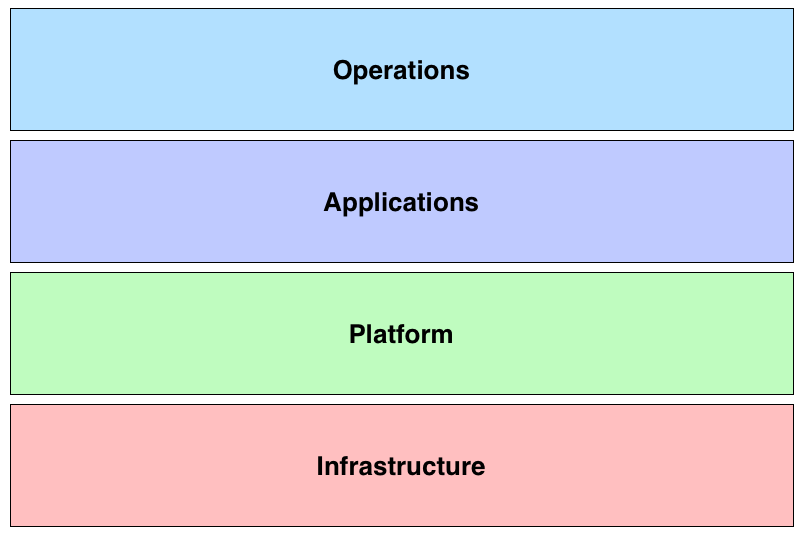
This is where the Advanced Media Workflow Association (AMWA) comes in. AMWA is an industry group of manufacturers, developers and end users, that is trying to advance a software-focussed approach to support future professional media operations. What this means in practice is identifying how to build upon “commodity” infrastructure (red layer) and widely used platform technologies/protocols (green) layer and supplement these where required with helpful specifications that build upon these building blocks. AMWA has done this in the past with “application specifications” for file-based interchange and delivery, and is now doing this for networked media with the NMOS specifications, which are being created by AMWA’s Networked Media Incubator group. These provide a open set of APIs to support interoperability for networked media applications:
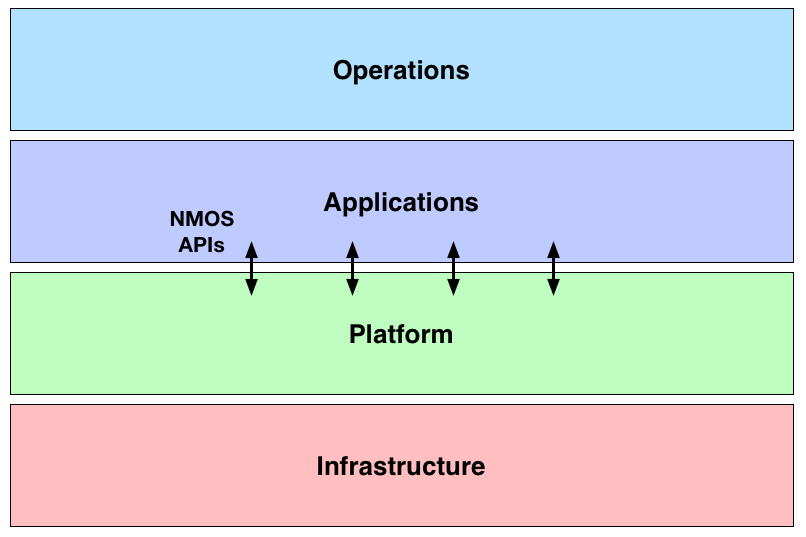
General Principles
When creating NMOS specifications we try to follow a number of general principles, which will be familiar to today’s developers.
Web-friendly protocols
In the past specialised wire protocols have often been used for the control plane within facilities. However networked media operations are becoming increasingly distributed across locations, and sometimes across organisational boundaries, including third-party/public cloud providers. So it is desirable to use protocols that are aimed at such environments. HTTP and WebSockets are examples of these, and this is what NMOS currently uses.
There is a huge amount of work happening in the wider IT/IP industry on optimising these protocols and their implementation, making previous arguments about the performance of specialised protocols less relevant.
Developer-friendly APIs
A decade ago, typical control APIs used an “RPC-style” approach based on SOAP, XML, XSD and WSDL, leading to quite complex code and messages. Modern developers of web APIs typically use a REST (or at least “REST-like”—see below) approach with simpler messages based on JSON and a lightweight approach to schemas using e.g. RAML and JSON Schema.
NMOS adopts this modern approach.
REST
Although “REST” is often used to mean any simple HTTP API, in creating the NMOS specs we have tried to adopt “correct practice” such as statelessness, uniform interface, resource identification in requests, HATEOAS, etc. (The Wikipedia REST page has a good summary of these.) But as there are no hard rules on this, and a certain amount of pragmatism has also been used, especially for more control-oriented activities such as connection management.
Technology independence through data modelling
This might seem to conflict with some of the above, but it doesn’t have to. In creating the NMOS specifications we have started with (UML) data models, which you will see in the NMOS repositories, and mapped these to JSON/HTTP/WebSockets/whatever. But should the wider IT/IP world migrate to new technologies, alternative mappings of the data models could feature in updated specifications.
Build on widely used and open foundations
The success of HTTP and WebSockets is in part due to their open nature, being made available through IETF RFCs. The same applies to RTP, which is the basis of much industry activity on live IP at present.
Openly available specifications
We are using GitHub repositories to publish the specifications. These are made public as soon as is sensible, and of couse are available at no cost (AMWA is using a “RAND-Z” model for this work). We use the Apache 2.0 open source licence for specifications (and the current open-source implementations).
Self-documenting specifications
Much of the “normative” part of the NMOS specifications takes the form of RAML and JSON Schema (with text-based supporting information). This allows for automatic generation of the HTML rendered API documentation you will see on the GitHub pages.
Scalable
The Internet/Web has scaled well so far (shortage of remaining public IPv4 addresses notwithstanding). NMOS APIs are built from Internet/Web technologies, so should also scale. That’s the theory – at the time of writing this we are planning some practical work to study/prove this is the case, including documenting best practice.
Securable
Huge amounts of resources are spent on ensuring the world can use the Internet/Web securely. NMOS APIs are built from Internet/Web technologies, so should benefit. Again, that’s the theory – so far Incubator workshops have used plain HTTP/WebSockets for expediency, but the specifications support HTTPS/WSS. At the time of writing this we are planning some practical work to study/prove this is the case, including documenting best practice (such as what authentication, authorisation and audit technologies are well suited to networked media applications).
Suitable for all types of platform
Professional media has to work in many different types of environment, requiring a range of types of equipment. This means that NMOS specifications have been designed to work on many types of platform, such as:
- low-power devices, used on location and connected on a local network
- rack-mounted equipment within a fixed facility in a television centre
- virtualised in an on-premesis data centre
- on a shared or public cloud
Universal identity
In NMOS specifications, everything is treated as a resource that can be uniquely identified. This is discussed in depth in the “Identity Framework” section of the JT-NM RA. In practice it means that every resource has a UUID/GUID that can be generated locally (rather than being assigned by a central authority). This UUID is then used within JSON messages and as part of RESTful URIs.
Flexible content
NMOS’s content model reflects the richness of use of content in modern productions. Video, audio and data are treated as separate elements with their own identity and timing information. This allows them to be handled as required during production and rendered for consumption as needed for the platform(s).
Use rather than invent
NMOS specifications apply techniques used more generally for the professional media industry. Where possible we use protocols, representations, technologies, etc. that have proved successful elsewhere.
Benefit from modern tooling
Similarly the NMOS specifications have been written with the intent that they will be implemented using technologies that are widely known by developers with experience of network and web development.
Guided by JT-NM RA
This has already been mentioned, but it underpins how work on future NMOS specifications is likely to develop, as it ensures the work stays relevant across a broad community.
NMOS Model and Terminology
Before explaining the NMOS specifications themselves it is helpful to present the model we are using in a sequence of pictures. This will also introduce some of the terminology used in NMOS specifications – this is similar to that used in the JT-NM RA. Be warned that in some cases common words (such as “Device”) are used to represent “logical” things and so may not mean what you expect. A more complete list of NMOS terminology is provided in the Glossary.
In NMOS specifications a Device represents a logical block of functionality, and a Node is the host for one or more Devices.
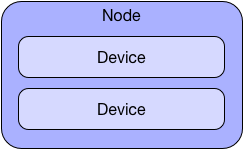
Devices have logical inputs and outputs called Receivers and Senders, for example:
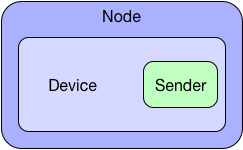
or:
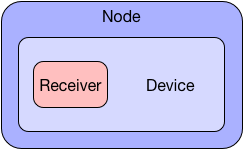
or:
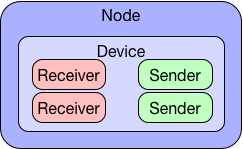
Devices, Senders and Receivers are all Resources. A Resource is a uniquely identified and addressable part of a networksed system:
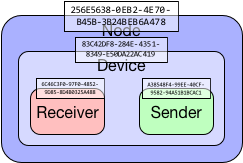
As an example, consider an IP-enabled camera. Associated with it there will probably be a Node, a Device, A video Sender, an audio Sender (if it has microphones), and maybe a data Sender (e.g. for position data), and perhaps Receivers for reverse video, intercom and control data.
NMOS uses the term Flow for a sequence of video, audio, or time-related data, which can flow from a Sender to a Receiver or Receivers. A Flow is treated as a resource and has a unique ID:

The elements within the Flow are called Grains. An example of a Grain is a video frame. Grains are associated with a position on a timeline:

Although Grains often are regularly spaced, they don’t have to be, for example in the case of Data Grains representing irregular events:

Each Flow is also associated with a Source. This is the logical originator of the Flow:
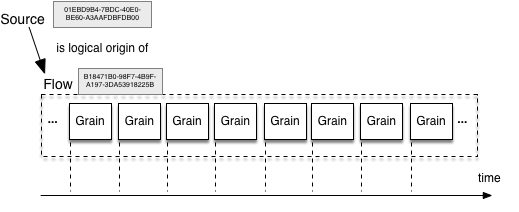
So in the NMOS model, a camera could be have several associated resources:
- Node
- Device
- Video, Audio and Data Sources
- Video, Audio and Data Senders
- Video, Audio and Data Receivers (for tally, viewfinder and comms)
- Video, Audio and Data Flows
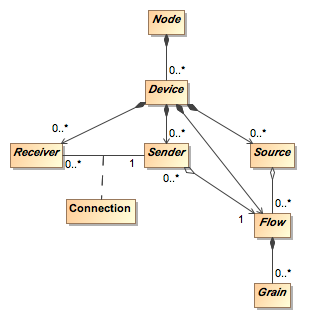
So far, NMOS specifications have worked with quite fine-grained Resources (pun unavoidable). Future NMOS specifications will consider functionality and content at a higher level, for example for detailing with “bundles” of Flows.
Reading the Specifications
Finding the Specifications
A current list of NMOS Specifications is at https://specs.amwa.tv/nmos:
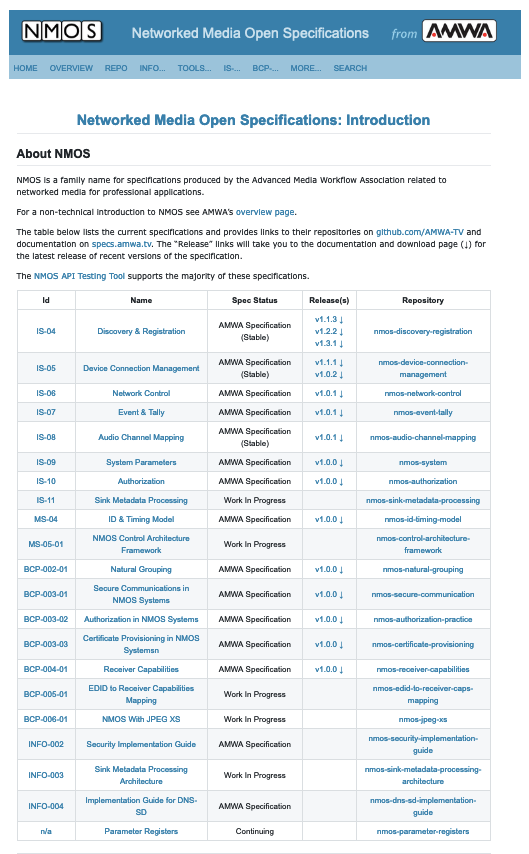
From there you can click on the entry in the “Name” column to go to the rendered HTML documentation for each Specification. Each Specification’s “home page” contains a short introduction, typically including:
- What does it do?
- Why does it matter?
- How does it work?
To see the GitHub repository that contains the source for the specification, click on the entry in the “Repository” column, or on “REPO” in the menu bar of the documentation. This takes you to the default git branch

Navigating the Specifications
The NMOS Interface Specications (IS-04 etc.) are layed out as below, where the directory names refer to what is in the repo:
/APIs/: RAML API definitions/APIs/schemas/with-refs/: JSON Schemas referenced from the RAML
/examples/: Example API messages/docs/: Normative and supporting documents, starting with an Overview.
The most imporant parts of these are listed on the Specification’s main documentation page:
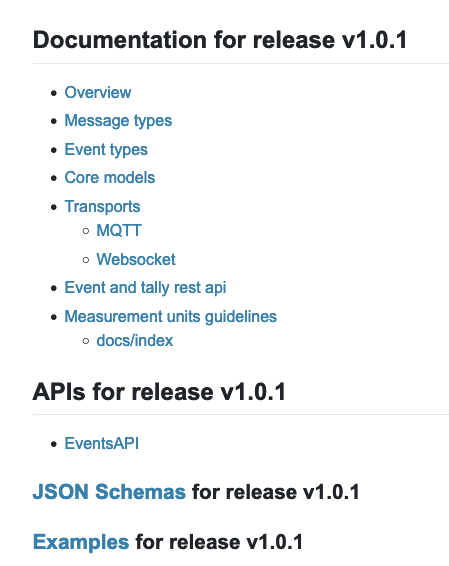
And you can also use menu options:
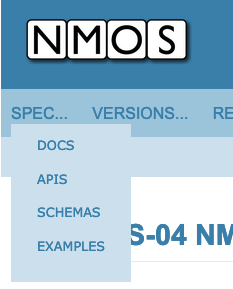
Selecting a Version
“VERSIONS…” in the documenation menu lets you select a particular release of a specification, or a live (development) branch:
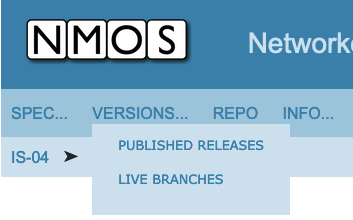
On the main Specification list, the “Version(s)” column lets you go directly to the documentation for the most important versions, and also download GitHub releases.
Other Menu Options
The documentation menu also allows you to go to the NMOS wiki, look at FAQs, access tools such as the NMOS test suite, switch to a different Specification, and search the documentation.
To search the repository, use the GitHub search feature.

To go back to the main Spec list, click the NMOS logo.
Viewing the APIs
You can download the RAML and schema files directly from the repo (in the directories listed above). But in many cases it may be easier to view rendered versions, such as this one for the IS-04 Node API:
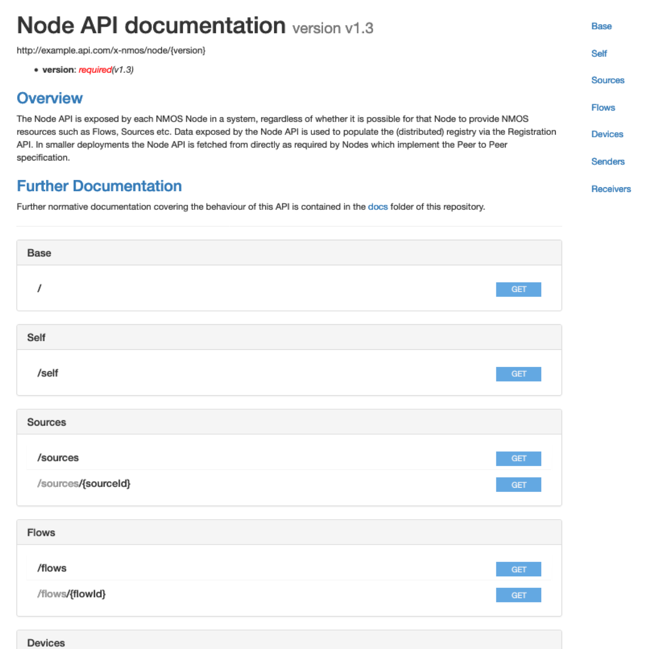
Then you can use the GET, PUT, etc. buttons to see a relevant request or response message, in this case for getting a source resource:
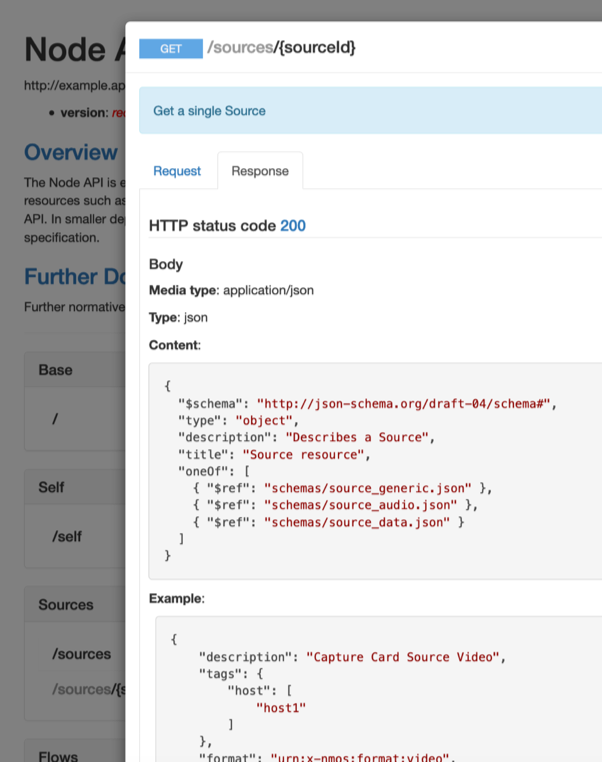
Note that this example includes three further referenced schemas. At present you will have to navigate to the “Schemas” page to see these. We hope to put in links soon though!
Viewing the Documentation
This is straightforward - just click on the relevant links.
←Introduction · Index↑ · FAQ→

